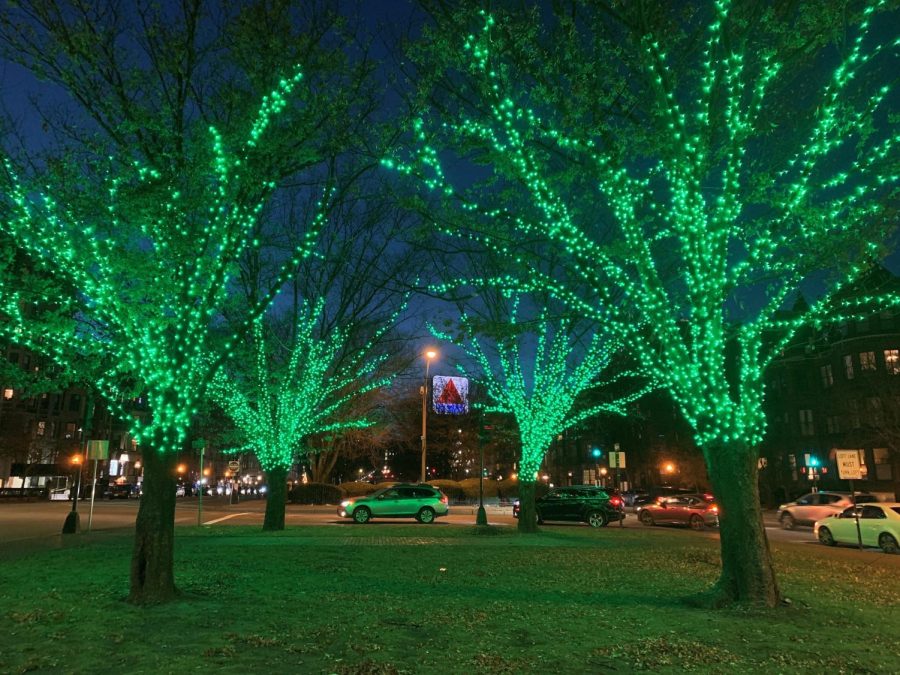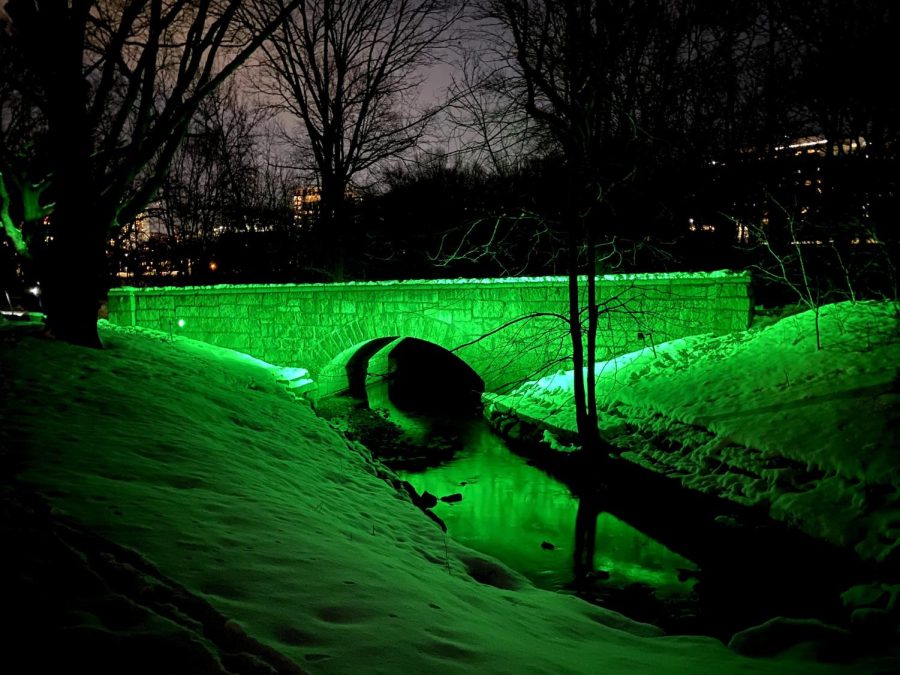Emerald Necklace Conservancy, Charlesgate Alliance advocate for parks, greenspaces to bridge communities
Emerald-colored lights wrap around the trees at Charlesgate Park as part of the “Lights in the Necklace” installation. Photo courtesy to Randall Albright.
January 28, 2022
Starting Feb. 1, the Emerald Necklace Conservancy, a nonprofit organization working to improve and restore Boston’s landscaping, will hold their second annual “Lights in the Necklace” installation. Every night from dusk to 9 p.m. until March 20, emerald-colored LED lights will illuminate the trees and historic bridges sprinkled across the Emerald Necklace, a system of nine parks comprising 1,100 acres of greenspace across Boston and Brookline.
Leaders at the Conservancy want the installation to draw attention to the abundance of greenery in the city. As cases of Omicron sweep the nation and outdoor gatherings offer a safer way to socialize, the Conservancy hopes “Lights in the Necklace” will help people appreciate the landscaping of the parks while fostering a sense of connection and community.
“[Lights in the Necklace is] for people to be able to be outside and find themselves more drawn to the parks. But also the symbolism of it [is] highlighting the bridges themselves,” said Veronika Trufanova, the Conservancy’s director of development and external relations. “Bridges are symbolic of bridging communities, bridging ourselves to each other.”
President of the Emerald Necklace Conservancy Karen Mauney-Brodek said planning “Lights in the Necklace” in 2021 created jobs for companies losing opportunities to use lighting equipment as the pandemic thwarted theatrical productions. In 2021, “Lights in the Necklace” also inspired Boston residents by providing a light experience during dark times.
With the goal of helping Boston residents combat seasonal depression and pandemic-related stressors while adding a flare to the city’s greenspace, Mauney-Brodek knew “Lights in the Necklace” was something she wanted to do again this year.
“This has been a real difficult, sad time for so many people. People have lost loved ones, people have been sick, people’s connections have broken down,” Mauney-Brodek said. “We thought, ‘How can we provide a light experience? How can we provide a safe evening activity bringing people to the parks?’”
In addition to illuminating greenspace for community building, the Conservancy is using the installation to raise awareness of their ongoing endeavor: the Charlesgate Revitalization Project that aims to improve the quality and accessibility of Boston’s parks.
According to a press release, the Conservancy is working to achieve their goals by partnering with several organizations, including the Massachusetts Department of Recreation and Conservation, the Massachusetts Department of Transportation and the Charlesgate Alliance, an organization dedicated to uniting Kenmore, Back Bay and Fenway and creating a sense of community by improving Charlesgate Park, the land that links these neighborhoods. Together, these organizations hope to unite Boston and Brookline parks with the Charles River Esplanade and Commonwealth Avenue Mall by re-imagining the infrastructure of Charlesgate Park.
Unlike well-manicured, popular greenspaces in the Emerald Necklace like Boston Common or the Arnold Arboretum, Charlesgate Park is often unkempt, unpopular and even unsafe.
Parker James, who has lived in the Charlesgate area for over four decades and is the co-founder of the Charlesgate Alliance, explained that the park is under the jurisdiction of the Commonwealth, not the city of Boston. Because of this, James said the park often goes unpoliced and has become a hub for illegal activity.
“It’s probably the only park in the city of Boston where it’s dangerous to go during the day,” James said. “We have right in the center of our fancy-looking neighborhood this, not only unusable, but dangerous park. And so we coalesced in order to figure out how to make park improvements.”
Charlesgate Park was not always in such dire shape. Designed in the 1870s by architect Frederick Law Olmsted, the same man who designed Central Park in New York City, the Emerald Necklace was envisioned as a large, natural-looking park system that would make passersby forget they were in the middle of a major city.
Instead, passersby today often forget they’re in the middle of a park. Many architectural and infrastructural decisions like highway, bridge and overpass construction made by the Massachusetts Department of Transportation have obscured Olmsted’s vision of Boston’s greenspace. But the Emerald Necklace Conservancy, the Charlesgate Alliance and several other organizations are working together to revitalize what once was.
“[Charlesgate Park] was designed to be the critical link of the entire Boston parklands,” James said. “Our goal is to revive the parkland, to make it accessible to all citizens and at the same time restore the connections so that Olmstead vision, which was America’s first fully integrated urban park system, is restored.”
Mauney-Brodek explained that the Emerald Necklace Conservancy and the Charlesgate Alliance want to develop a dog park and playground to attract people to the area. James also said they have plans to install outdoor exercise equipment and swings that resemble those at The Lawn on D in Seaport.
On top of installing attractions, a big goal of these greenspace advocates is to restore the health of the Muddy River, a hidden, unhealthy greenish-brown body of water that runs through the Emerald Necklace and Charlesgate region. Improving the conditions of the Muddy River — and the Charlesgate Park as a whole — has positive implications for Boston’s capacity to deal with the increasingly threatening effects of climate change: rising sea-levels and stormwater floods.
“We have a major project on the restoration of the Muddy River and dredging to make sure it’s flood capacity is improved and that the Emerald Necklace is able to absorb the storm water and the rainwater … as it was designed to do from the beginning,” Trufanova said.
James said that the project to revitalize Charlesgate Park will bring long-lasting and worthwhile benefits to this densely populated area of Boston, and he hopes that the implementation of their vision will re-inject life into the neglected park.
Although the Emerald Necklace Conservancy and Charlesgate Alliance concocted a well-developed and intricate plan to restore Charlesgate Park and relink the Boston’s greenspace, Trufanova said that different regions of the Emerald Necklace are under the jurisdiction of either the city of Boston, the city of Brookline or the Massachusetts Department of Conservation and Recreation. This means neighborhood advocacy groups like the ones involved in the Charlesgate Revitalization Project don’t have the power to carry out their plans without the approval of the entities that own the land.
Because of this, James said that no one involved in the initiative knows exactly when the project will be carried out. However, they can continue to lobby and converse with the people and departments in power.
“I said to [the architects], ‘What I want you to produce is designs that are so good and make so much sense that if by chance they didn’t get built, future generations of Bostonians will curse the powers that be for not building them,’” James said.
Editor’s note: The story was updated Friday Jan. 28 at 10:00 p.m. to accurately reflect the duration of the “Lights in the Necklace” installation.



















